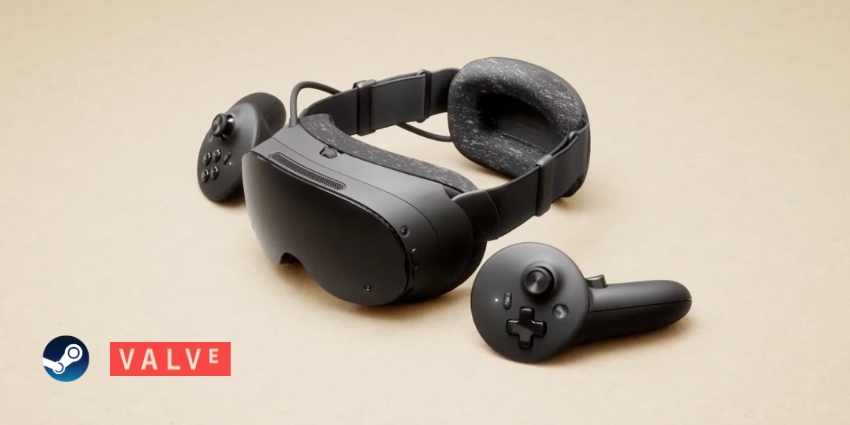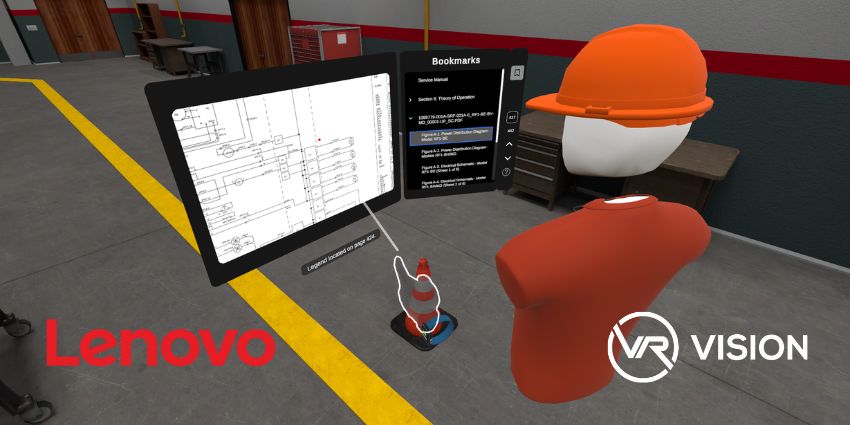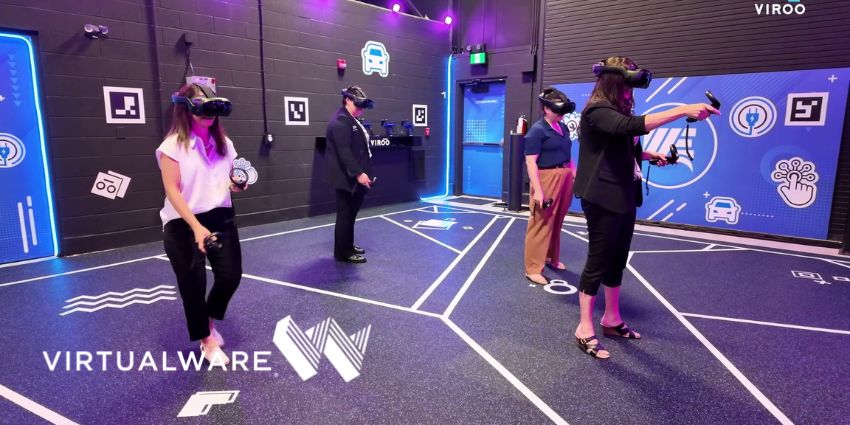Are virtual reality headsets bad for your eyes? As VR devices continue to gain popularity in both the consumer and business landscapes, many potential users are asking this question. After all, for years, we’ve been told that “too much screen time” can cause eye fatigue, headaches, and more.
Our parents even warned us that sitting too close to a television screen when we were young could cause all kinds of damage. So, what happens when we place a pair of screens just a few centimeters in front of our eyes? The simple answer is that researchers are still trying to figure that out.
VR might have been around for decades at this point, but it’s really only just become a mainstream technology. As the virtual reality landscape evolves, affecting everything from collaboration, to how we train team members, should we be concerned about vision health?
Let’s take a look at the facts.
Are Virtual Reality Headsets Bad for Your Eyes? The Basics
Currently, the amount of research on VR headsets and their impact on vision is extremely limited. Only a handful of studies have emerged in the last couple of years, and the general consensus from researchers is that VR devices “may” cause eye problems, but it’s uncertain.
So, why have so many optometrists raised concerns in recent years? The simple answer is that we already know “digital eye strain” is a real issue. Over the years, countless eye experts and researchers have acknowledged that regular exposure to screens and digital devices can impact our vision. We’re not sure if the effects are long-term. However, increased use of screens can lead to a multitude of problems with headaches, blurry eyes, watery eyes, and fatigue.
Human beings aren’t designed to look at screens all day. These screens use a combination of technologies to present a clear image, but they also expose us to issues like glare, poor lighting, and rapid refresh rates. On top of that, we often forget to blink regularly when looking at a screen, which can gradually cause the eyes to dry out.
The more we expose ourselves to “screen time”, the more we suffer with things like “Asthenopia” (eye fatigue), neck and shoulder pain, and even double vision.
Because of this, optometrists usually recommend adding distance between digital screens and your eyes. However, VR headsets require us to place screens as close to our eyes as physically possible, which is when concerns begin to emerge.
From Digital Eye Strain to VR Sickness
Ongoing research into digital eye strain, or “computer vision syndrome,” is just one of the reasons optometrists and consumers are asking: “Are virtual reality headsets bad for your eyes?” While researchers might not have much time to examine the direct link between VR and vision loss, many have examined the concept of VR sickness.
We already know that spending excessive time in VR can cause short—to mid-term side effects, many of which impact vision. VR sickness can lead to headaches and dizziness, difficulty maintaining balance, nausea, and more.
Although some of these side effects can impact your vision, for instance, dizziness and blurry eyes can often go hand in hand, it’s difficult to know if VR sickness and eye issues are directly related. That being said, many experts offering recommendations on how to reduce VR sickness do suggest “fixes” that are linked to our vision.
For instance, choosing a headset with high-quality screens is a good way to reduce VR sickness. Some of the more traditional VR headsets on the market typically use 2 LCD monitors, which is similar to placing two smartphones side-by-side in front of your eyes.
As mentioned above, your eyes aren’t designed to look at these screens that closely. Usually, you need to work much harder to process all of the information you’re seeing on a screen, which is why so many people suffer from eye fatigue and headaches.
Choosing headsets with minimal latency, higher refresh rates, and better graphics can also reduce VR sickness. The less we see lag, flashing images, and distortion, the less our eyes will likely suffer.
Are Virtual Reality Headsets Bad for Your Eyes Today?
One thing worth noting is that most of the (limited) research into the impact of VR headsets on eyesight is a little outdated. Many optometrists and experts are basing their concerns on the assessment of how older headsets impact vision, and cause VR sickness.
Today’s virtual reality headsets have come a long way in just a few years. Modern devices use more advanced, high-resolution screens with better refresh rates and pixel density, which helps reduce eye strain.
On top of that, VR innovators are investing in various ways to reduce VR sickness, and common side effects from VR usage. For instance, we now have:
- Better headset designs: Manufacturers are constantly refining headset designs to reduce both eye strain and motion sickness. Most modern headsets have wider fields of view, blue light filters, better ergonomics, and reduced latency.
- Customizable headsets: Many VR headsets allow users to customize certain aspects of their experience, like “interpupillary distance” and screen brightness. This can help to reduce eye strain. You can even access headsets with built-in lenses and corrective elements if you already have vision issues.
- Improved software: App designers working on VR interfaces and solutions are leveraging technology to more effectively simulate depth and distance. This can actually help human eyes practice focusing at different distances.
- Increased awareness: As VR headsets become more mainstream, there’s a greater emphasis on educating users about careful and healthy usage. A lot of manufacturers and VR leaders offer advice on how to reduce eye strain and VR sickness. Adjusting display settings, being mindful of pre-existing conditions, and taking breaks regularly can reduce issues.
Could VR Headsets Be Good for Your Eyes?
If we’re trying to answer the question: “Are virtual reality headsets bad for your eyes?” it makes sense to look at the debate from the other side, too. While there will always be people who suffer more when using virtual reality devices than others, VR headsets can have health benefits, too.
Many pioneers in the world of virtual reality healthcare are creating programs and systems specifically designed to treat and correct certain vision issues.
Some programs are using VR systems to correct vision problems like “lazy eye” by training the eye muscles to focus on content at various distances. VR applications can also help improve hand-eye coordination, enhance depth perception, and boost reaction speed.
VR apps can even help train optometrists and provide professionals with insights into factors that contribute to sight loss, which could lead to the development of better treatment programs.
Notably though, most leaders investing in VR to correct sight issues are focusing on adult patients. Although there’s limited insight available into how virtual reality affects the vision of children, there is a concern that too much screen time could contribute to myopia progression in younger people.
Plus, while adults using VR can monitor themselves and take breaks when necessary, children may not have the insight or awareness to rest their eyes as frequently as they should.
How to Minimize the Eye Risks of VR
Currently, there’s very little evidence to suggest that the answer to “Are virtual reality headsets bad for your eyes?” is a definite “yes.” However, with any technology, overuse and improper usage can often lead to negative side effects. The easiest way to reduce your risk of eye issues and motion sickness problems with VR, AR, and MR headsets is to follow usage guidelines.
In other words, follow the advice of VR manufacturers and don’t use your headset for hours at a time, particularly if you already have vision problems. Limit your “screen time” and take regular breaks to rest your eyes. Adjust the display settings on your device (brightness, contrast, and font size) for a more comfortable viewing experience.
Additionally, make sure that you’re using blue light filters (when possible) to reduce eye strain. It also makes sense to ensure you’re customizing your headset, where possible, to include lenses that adhere to any vision problems you might have. Other quick tips include:
- Adjusting IPD on your headset to reduce strain
- Choosing a headset with a high resolution and refresh rate
- Blinking regularly when you use your VR headset
- Keep up with regular eye health appointments
Are Virtual Reality Headsets Bad for Your Eyes? Probably Not
Ultimately, concerns about the impact of VR on vision health are valid (particularly when we acknowledge the issue of digital eye strain). However, the reality is that there are no clear links between VR technology and long-term eye issues. At worst, it seems likely that consistent or improper use of a VR headset might cause eye strain, fatigue, and a few other short-term issues.
However, if you take the correct precautions and regular breaks, you can usually mitigate common issues. Additionally, as manufacturers continue to produce more advanced headsets with better screens, user-experience-focused software, and ergonomic hardware, the risks will continue to diminish. The better our virtual reality headsets are at presenting content in a natural, eye-friendly format, the less eye strain we’ll encounter.
While there’s no guarantee that you won’t encounter the occasional problem when using VR for collaboration, or product design, there’s no evidence to suggest you should be too worried. Your vision should be safe in the long term if you take the right precautions.








